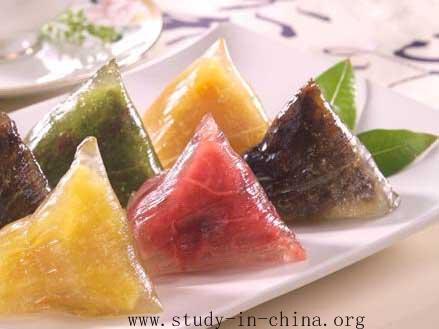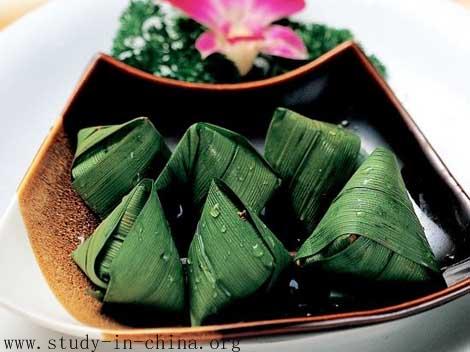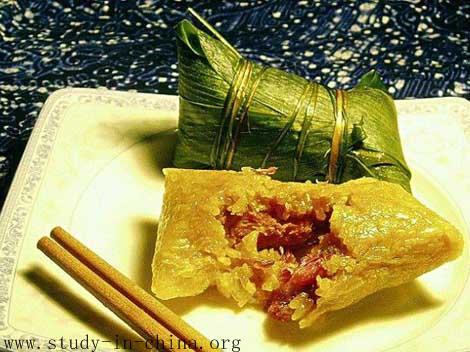more>>More News
Rice Dumpling
By admin on 2015-01-30
Many traditional Chinese foods are intended to honor either the gods or divine persons in history. Zong Zi - a glutinous rice dumpling wrapped in bamboo or reed leaves - is no exception. It is meant to honor Qu Yuan (340-278 BC.), the pioneer poet of ancient China.

Qu Yuan was a famous poet who
was also concerned about the fate of his government. Unfortunately his stature
aroused the jealousy of the king, who banished him to a remote area. The poet
despaired of the government and its policies. When the state's capital was
captured by enemies, he committed suicide by drowning himself in the Miluo River
(on May 5th according to the Chinese lunar calendar). The Chinese people felt
this loss deeply, as he was a much beloved poet. Local folk searched for him in
the river, meanwhile dropping dumplings of glutinous rice wrapped in bamboo or
reed leaves into the river in order to keep the fishes from attacking Qu Yuan's
body.
Since that time, it has been
customary on this day to enjoy Zong Zi dumplings as a memorial to the patriotic
poet. In addition, there is also a festival called the Duan Wu or Dragon Boat
Festival. If you ever visit China during the Dragon Boat Festival, you can't
miss the nationwide custom of enjoying Zong Zi. You are sure to be impressed
with the delicacy of this snack, and with the faint scent of the leaves
imprinted on the skin of the dumplings.
I
still remember making and enjoying Zong Zi as a child. Along with my brothers
and sisters I hovered around the stove, begging to have a taste, unable to wait
until they were cooked. We were very eager since the food was made only once a
year on May 5th. But now it is quite different. The Chinese Zong Zi is not only
made for the Duan Wu Festival. It is available at any time of the year. And
local areas have developed their own styles and varieties of
dumpling.
The main ingredient of Zong Zi is the glutinous rice. The next
most important ingredient is the bamboo or reed leaves which form the wrapping
and make Zong Zi distinct from other types of Chinese dumplings. The filling
often contains either dates or sweetened red bean paste. These are the ones I
once had in my family. I like them much more than the ones with meat but my
brother doesn't. He says the meat ones are terrific.
The leading place
for the food is Jia Xing, an ancient town in Zhejiang province. Many different
types of Zong Zi are made here. At Wu Fang Zhai, a monopolistic food processor,
you'll find all the ingredients you need: the dumplings with meat, sweetened
bean paste and chestnuts, lotus seeds, dates, and yolk of egg.

If the materials are
available to you, it is quite possible for you to make Chinese Zong Zi at home;
both for pleasure and maybe also to honor the great poet, Qu Yuan. By the way,
in the year 2006 the Dragon Boat Festival happens to fall on May 31st, according
to the solar calendar. You'd better prepare a net for the fish.
Here is a
recipe for Zong Zi:
(makes ten dumplings)
1. 50 sheets of bamboo or reed
leaves
2. Glutinous rice (1 kilogram)
3. Chinese dates (250
grams)
Directions:
1.Soak the rice and the dates 12 hours or more
till they are soaked thoroughly.
2.Wash the leaves.
3.A chopping board is
necessary for laying out the leaves.
4.Fold the leaves flat at the leafstalk
to make a sheet.
5.Hold the sheet, fold it round in the middle and make a
funnel till both ends are laid over each other in one direction.
6.Use about
1/10 kg. of rice and 6 dates for each dumpling. The dates must be covered by the
rice so that they won't lose too much syrup in cooking.
7.Fold the leaves up
to seal the open side of the funnel and tie the bundle with a band made of
twisted leaves. Make sure that the bundle is tied neither too tight nor too
loose. This helps make sure that the ingredients are well cooked.
8.Put the
dumplings in a pot, cover with water and make sure they are pressed and kept
still while being boiled.
9.Cooking time: 40 minutes in a pressure cooker; 2
hours in an ordinary pot.
- Contact Us
-
Tel:
0086-571-88165708
0086-571-88165512E-mail:
admission@cuecc.com
- About Us
- Who We Are What we do Why CUECC How to Apply
- Address
- Study in China TESOL in China
Hangzhou Jiaoyu Science and Technology Co.LTD.
Copyright 2003-2024, All rights reserved





 Chinese
Chinese
 English
English
 Korean
Korean
 Japanese
Japanese
 French
French
 Russian
Russian
 Vietnamese
Vietnamese
